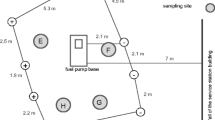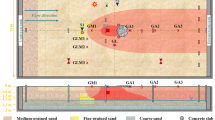Abstract
An in-situ remediation procedure is proposed to remove Volatile Organic Compounds (VOCs) dissolved in groundwater. This is accomplished by injecton of air into a well, using a combined technique of air-lift pumping with a form of vapor stripping. When air is injected into a well, it causes water to be lifted and forces groundwater flow towards the well, creating a recirculating cleanup zone. During this process, VOCs are transferred from the contaminated water to the rising air bubbles inside the well. The air bubbles are separated from the liquid near the top of the well, and the VOC vapor is collected and treated. In this system, water is not permitted to be lifted to the ground surface. Rather, the water is diverted into the unsaturated zone through a series of drains that are installed beneath the root-zone. The water then, free of a portion of VOCs, infiltrates back to the water table. As water continues to circulate, the VOC concentrations are gradually reduced.
The feasibility of the proposed method was analyzed using concepts of mass transfer of VOCs from water to air-bubbles. Calculations indicate that the method has promise because equilibrium partitioning between the contaminated liquid and the gas bubbles is rapidly established.
Similar content being viewed by others
References
Abelson, P. H., 1990, Volatile contaminants of drinking water.Science 247, (4939), 141.
Akita, K. and Yoshida, F., 1974, Bubble size interfacial area and liquid phase mass transfer coefficient in bubble columns,Industrial Eng. Chem., Proc. Des. Develop. 13(1), 84–91.
Baehr, A. L., Hoag, G. E., and Marely, M. C., 1989, Removing volatile contaminants from the unsaturated zone by inducing advective air-phase transport,J. Contam. Hydrol. 4, 1–26.
Bailey, J. E. and Ollis, D. F., 1986,Biochemical Engineering Fundamentals, McGraw-Hill, New York.
Calderbank, P. H. and Moo-Young, M. B., 1961, The continuous phase heat and mass-transfer properties of dispersions,Chemical Eng. Sci. 16, 39–54.
Dilling, W. L., 1977, Interface transfer processes II, evaporation rates of chloromethanes, ethans, ethylenes, propanes, and propylenes from dilute aqueous solutions,Environ. Sci. and Tech. 11(4), 405–409.
Driscoll, F. G., 1986,Groundwater and Wells, Johnson Division, St. Paul, Minn.
Gardescu, I. I., 1930, Behavior of gas bubbles in capillary spaces,Trans. AIME 86, 351–370.
Garretson, G. A., 1973, Bubble transport theory with application to the upper ocean,J. Fluid Mech. 59, 187–207.
Govier, G. W. and Aziz, K., 1972,The Flow of Complex Mixtures in Pipes, Van Nostrand Co., New York.
Goldenberg, L. C., Hutcheon, I., and Wardlaw, N., 1989, Experiments on transport of hydrophobic particles and gas bubbles in porous media,Transport in Porous Media 4, 129–145.
Herrling, B., Beurmann, W., and Stamm, J., 1990, In-situ remediation of volatile contaminants in groundwater by a new system of under-pressure-vaporizer-wells,Proc. Subsurface Contamination by Immiscible Fluids, April 1990, Calgary.
Hines, A. L. and Maddox, R. N., 1985,Mass Transfer, Fundamentals and Applications, Prentice-Hall, Englewood Cliffs, N.J.
Hoag, G. E. and Marley, C. M., 1986, Gasoline residual saturation in unsaturated uniform aquifer materials,J. Environ. Eng. 112(3), 586–604.
Hornsby, D. and Jela, J., 1982, Selective floatation and its surface chemical characteristics,Surface Colloid Sci. 12, 217–314.
Hunt, J. R., Sitar, N. and Udell, K. S., 1988, Nonaqueous phase liquid transport and cleanup, 1. analysis of mechanisms,Water Resour. Res. 24(8), 1247–1258.
Johnson, E. E. Inc., 1975,Ground Water and Wells, Johnson Division, UOP Inc., St. Paul, Minn.
Jury, W. A., Spencer, W. F., and Farmer, W. J., 1983, Behavior assessment model for trace organics in soil: 1. model description,J. Environ. Qual. 12(4), 558–564.
Kavanaugh, M. C. and Trussell, R. R., 1981, Air stripping as a treatment process, inOrganic Chemical Contaminants in Groundwater: Transport and Removal, AWWA Summer Proc, Report No. 20156, Denver, pp. 83–106.
Kirshen, N., 1984, Analysis of trace volatile organic chemicals in water by purge and trap capillary GC,American Laboratory (Dec.), 60–67.
Lenhard, R. J. and Parker, J. C., 1987, A model for hysteretic constitutive relations governing multiphase flow, 2. permeability-saturation relations,Water Resour. Res. 23(12), 2197–2206.
Leverett, M. C., 1941, Steady flow of gas-oil-water mixtures through unconsolidated sands,Trans. AIME 142, 107–116.
Levich, V. G., 1962,Physicochemical Hydrodynamics, Prentice-Hall, Englewood Cliffs, N. J.
Mackay, D., Shiu, W. Y., and Sutherland, R. P., 1979, Determination of air-water Henry's Law constants for hydrophobic pollutants,Environ. Sci. Technol. 13(3), 333–337.
McDonald, M. G. and Harbaugh, A. W., 1985, A modular 3-dimensional finite-difference groundwater flow model, U.S. Geological Survey, Open File Rep. No. 83-875.
McCarty, P. L., 1988, Bioengineering issues related to in-situ remediation of contaminated soils and groundwater, in G. S. Omenn (ed.),Environmental Biotechnology, Plenum Pres, New York pp. 143–162.
Memery, L. and Merlivat, L., 1985, Modeling of gas flux through bubbles at the air-water interface,Tellus 37B, 272–285.
Morrow, N. R. and Heller, J. P., 1985, Fundamentals of enhanced recovery, in E. C. Donaldson, G. V. Chilingarian and T. F. Yen, (eds),Enhanced Oil Recovery, 1. Fundamentals and Analyses, Elsevier, Amsterdam, pp. 47–74.
Parker, J. C., Lenhard, R. J., and Kuppusamy, T., 1987, A parametric model for constitutive properties governing multiphase flow in porous media,Water Resour. Res. 23(4), 618–624.
Peck, A. J., 1960, The water table as affected by atmospheric pressure,J. Geograph. Res. 65(8), 2382–2388.
Pollock, D. W., 1988, Semianalytical computation of path lines for finite difference models,Ground Water 26(6), 743–750.
Porter, J. W., 1989, Hazardous waste cleanup programs: a critical review,Chem. Eng. Prog. 85(4), 16–25.
Roberts, P. V., Goltz, M. N., and Mackay, D. M., 1986, A natural gradient experiment on solute transport in sand aquifer, 3, Retardation estimates and mass balance for organic solutes,Water Resour. Res. 22(13), 2047–2058.
Ronen, D., Berkowitz, B., and Magaritz, M., 1989, The development and influence of gas bubbles in phreatic aquifers under natural flow conditions,Transport in Porous Media,4(3), 295–306.
Ruckenstein, E., 1981, The physical meaning of the exponent for heat or mass transfer coefficients,Chem. Eng. Commun. 10, 77–80.
Schwille, F., 1988,Dense Chlorinted Solvents in Porous and Fractued Media, Lewis Publ. Inc., New York.
Skelland, A. H. P., 1974,Diffusional Mass Transfer, Wiley-Interscience, New York.
Sleep, B. E. and Sykes, J. F., 1989, Modeling the transport of volatile organics in variably saturated media,Water Resour. Res. 25(1), 81–92.
Stonestrom, D. A. and Rubin, J., 1989, Air permeability and trapped-air content in two soils,Water Resour. Res. 25(9), 1959–1969.
Sutcliffe, W. H., Baylor, E. R., and Menzel, D. W., 1963, Sea surface chemistry and Langmuir circulation,Deep-Sea Res. 10, 233–243.
Tchobanoglous, G. and Schroeder, E., 1987,Water Quality, Addison-Wesley, Reading, MA.
Thornton, J. S. and Wootan, W. L. Jr., 1982, Venting for the removal of hydrocarbons vapors from gasoline contaminated soil.J. Environ. Sci. Health. A17(1), 31–44.
Wilson, J. W., 1981, Determination of volatile organics in industrial and municipal wastewater, EPA-600/S4-81-071.
Wilson, J. T. and Wilson, B. H., 1985, Biotransformation of trichloroethylene in soil,Appl. Environ. Microb. 49(1), 242–243.
Author information
Authors and Affiliations
Rights and permissions
About this article
Cite this article
Gvirtzman, H., Gorelick, S.M. The concept of in-situ vapor stripping for removing VOCs from groundwater. Transp Porous Med 8, 71–92 (1992). https://doi.org/10.1007/BF00616893
Received:
Revised:
Issue Date:
DOI: https://doi.org/10.1007/BF00616893




